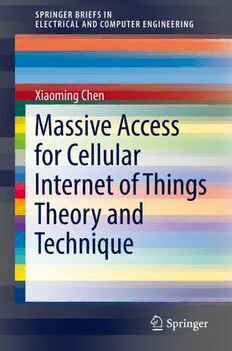Table Of ContentSPRINGER BRIEFS IN
ELECTRICAL AND COMPUTER ENGINEERING
Xiaoming Chen
Massive Access
for Cellular
Internet of Things
Theory and
Technique
123
SpringerBriefs in Electrical and Computer
Engineering
Serieseditors
Woon-SengGan,SchoolofElectricalandElectronicEngineering,Nanyang
TechnologicalUniversity,Singapore,Singapore
C.-C.JayKuo,UniversityofSouthernCalifornia,LosAngeles,CA,USA
ThomasFangZheng,ResearchInstituteofInformationTechnology,Tsinghua
University,Beijing,China
MauroBarni,DepartmentofInformationEngineeringandMathematics,University
ofSiena,Siena,Italy
SpringerBriefs present concise summaries of cutting-edge research and practical
applications across a wide spectrum of fields. Featuring compact volumes of 50
to 125 pages, the series covers a range of content from professional to academic.
Typicaltopicsmightinclude:timelyreportofstate-of-theartanalyticaltechniques,
a bridge between new research results, as published in journal articles, and a
contextualliteraturereview,asnapshotofahotoremergingtopic,anin-depthcase
study or clinical example and a presentation of core concepts that students must
understandinordertomakeindependentcontributions.
Moreinformationaboutthisseriesathttp://www.springer.com/series/10059
Xiaoming Chen
Massive Access for Cellular
Internet of Things Theory
and Technique
123
XiaomingChen
ZhejiangUniversity
Hangzhou,Zhejiang,China
ISSN2191-8112 ISSN2191-8120 (electronic)
SpringerBriefsinElectricalandComputerEngineering
ISBN978-981-13-6596-6 ISBN978-981-13-6597-3 (eBook)
https://doi.org/10.1007/978-981-13-6597-3
LibraryofCongressControlNumber:2019935144
©TheAuthor(s),underexclusivelicensetoSpringerNatureSingaporePteLtd.2019
Thisworkissubjecttocopyright.AllrightsarereservedbythePublisher,whetherthewholeorpartof
thematerialisconcerned,specificallytherightsoftranslation,reprinting,reuseofillustrations,recitation,
broadcasting,reproductiononmicrofilmsorinanyotherphysicalway,andtransmissionorinformation
storageandretrieval,electronicadaptation,computersoftware,orbysimilarordissimilarmethodology
nowknownorhereafterdeveloped.
Theuseofgeneraldescriptivenames,registerednames,trademarks,servicemarks,etc.inthispublication
doesnotimply,evenintheabsenceofaspecificstatement,thatsuchnamesareexemptfromtherelevant
protectivelawsandregulationsandthereforefreeforgeneraluse.
Thepublisher,theauthorsandtheeditorsaresafetoassumethattheadviceandinformationinthisbook
arebelievedtobetrueandaccurateatthedateofpublication.Neitherthepublishernortheauthorsor
theeditorsgiveawarranty,expressorimplied,withrespecttothematerialcontainedhereinorforany
errorsoromissionsthatmayhavebeenmade.Thepublisherremainsneutralwithregardtojurisdictional
claimsinpublishedmapsandinstitutionalaffiliations.
ThisSpringerimprintispublishedbytheregisteredcompanySpringerNatureSingaporePteLtd.
The registered company address is: 152 Beach Road, #21-01/04 Gateway East, Singapore 189721,
Singapore
Preface
WearelivingintheeraoftheInternetofThings(IoT),whichhasaffectedandeven
changed our styles of work, study, and life in depth. Everyday, from the time we
wakeup,weareusedtocheckingtheweatherforecastfromtheIoT.Whenwegoto
bedatnight,theIoTisstillmeasuringoursleepinginformation.Nowadays,wehave
beensurroundedbyvariousIoTdevicesathome,ontheroad,andintheoffice.All
thetime,alotofnewdevicesaccesstheIoTnetwork,andtheIoTnetworkbecomes
biggerandbigger.ItispredictedthatthenumberofIoTdeviceswillreachto20.4
billionby2020.
Without doubt, to achieve the goal of IoT, the focus is on the Internet, but not
thethings.Especially,theIoTdevicesshouldbeinterconnectedthroughawireless
mode. Currently, the IoT devices access various wireless networks mainly via the
Zigbee, Bluetooth, and Wi-Fi techniques. However, these techniques only support
moderateandsmall-rangewirelessaccess,e.g.,inthebuildingorcampus.Yet,more
andmoreIoTapplicationsrequireaseamlessaccessoveralargerange.Forinstance,
we usually run with some wearable devices around the West Lake in Hangzhou.
In this case, the traditional techniques cannot provide reliable wireless access for
a massive number of IoT devices. It is clear that a promising solution is the use
of the existing cellular networks, namely, cellular IoT. In this context, 3GPP (3rd
GenerationPartnershipProject)madeaspecificationforthecellularIoTinRelease
13in2015.Inparticular,bymakinguseofavarietyofnewradiotechniques,e.g.,
massive MIMO, NOMA, mmWave, and new waveform, the 5G cellular network
is expected to provide massive access for the cellular IoT with stringent QoS
requirements,e.g.,lowlatency,ultra-reliability,lowpower,andhighmobility.Thus,
thecellularIoTcansatisfytherequirementofvariousIoTapplications.
Even with new radio techniques, it is not a trivial task for the 5G to support
massive access of the cellular IoT over limited radio spectrum. Especially, there
are various different IoT scenarios, which may not have a unified solution. In
this book, we aim to present some feasible solutions for a few typical cellular
IoT scenarios from the viewpoints of both theory and technique. In Chap.1, we
introducethecharacteristicsofthecellularIoTanditskeytechniquesforachieving
efficientmassiveaccess.Next,Chap.2addressestheproblemofmassiveaccessof
v
vi Preface
the cellular IoT over stationary channels in the scenario of fixed devices. Then,
Chap.3 considers the cellular IoT over slowly time-varying fading channels in
FDD (frequency division duplex) mode. The achievable rate is analyzed, and the
corresponding performance optimization methods are provided. Then, the cellular
IoToverslowlytime-varyingfadingchannelinTDD(timedivisionduplex)modeis
studied;anewfullynon-orthogonalcommunicationframeworkformassiveaccess
isproposed.Furthermore,thehigh-mobilityscenarioofthecellularIoTisdiscussed
in Chap.5, and a beamspace massive access technique is designed based on the
available channel state information. Finally, we present a summary about massive
access for the cellular IoT in 5G and beyond and point out the future research
directions for further improving the overall performance of the cellular IoT in
Chap.6. It is sincerely expected that this book can provide useful insights for the
designandoptimizationofthecellularIoT.
Hangzhou,China XiaomingChen
August2018
Contents
1 Introduction .................................................................. 1
1.1 CellularIoT ................................................... 1
1.1.1 WhyIsCellularIoT .................................. 3
1.1.2 CellularIoTin5GandBeyond...................... 4
1.2 AnOverviewofMassiveAccessfortheCellularIoT ...... 5
1.2.1 CSIAcquisition....................................... 6
1.2.2 UserClustering ....................................... 6
1.2.3 SuperpositionCoding ................................ 7
1.2.4 SuccessiveInterferenceCancellation................ 8
1.3 ObjectiveofThisBook....................................... 8
References..................................................................... 11
2 MassiveAccesswithFullChannelStateInformation ................... 15
2.1 Introduction ................................................... 15
2.2 SystemModelandProblemFormulation.................... 17
2.3 DesignofMassiveAccessSystem........................... 20
2.3.1 WeightedSumRateMaximizationDesign.......... 21
2.3.2 TotalPowerConsumptionMinimizationDesign ... 26
2.4 NumericalResults ............................................ 29
2.5 Conclusion .................................................... 33
AppendixA ProofofLemma1............................................. 34
AppendixB ProofofProposition1 ........................................ 35
References..................................................................... 36
3 MassiveAccesswithChannelQuantizationCodebook.................. 39
3.1 Introduction ................................................... 39
3.2 SystemModelandProblemFormulation.................... 41
3.3 PerformanceAnalysisandOptimization .................... 44
3.3.1 AverageTransmissionRate .......................... 44
3.3.2 PowerAllocation ..................................... 47
3.3.3 FeedbackDistribution................................ 50
vii
viii Contents
3.3.4 ModeSelection ....................................... 52
3.3.5 JointOptimizationScheme........................... 53
3.4 AsymptoticAnalysis.......................................... 53
3.4.1 InterferenceLimitedCase............................ 53
3.4.2 NoiseLimitedCase................................... 58
3.5 NumericalResults ............................................ 58
3.6 Conclusion .................................................... 63
References..................................................................... 63
4 MassiveAccesswithChannelReciprocity ................................ 65
4.1 Introduction ................................................... 65
4.2 SystemModelandProblemFormulation.................... 67
4.2.1 Non-orthogonalChannelEstimation ................ 67
4.2.2 Non-orthogonalMultipleAccess .................... 70
4.3 AnalysisofFullyNon-orthogonalCommunication......... 72
4.3.1 SpectralEfficiencyofFullyNon-orthogonal
Communication....................................... 73
4.3.2 TheMulti-cellCase................................... 77
4.3.3 Asymptotic Characteristics of Fully
Non-orthogonalCommunication .................... 78
4.4 OptimizationofFullyNon-orthogonalCommunication.... 82
4.4.1 OptimizationofNon-orthogonalChannel
Estimation............................................. 82
4.4.2 OptimizationofNon-orthogonalMultipleAccess.. 84
4.5 NumericalResults ............................................ 87
4.6 Conclusion .................................................... 92
References..................................................................... 92
5 MassiveAccesswithChannelStatisticalInformation ................... 95
5.1 Introduction ................................................... 95
5.2 SystemModelandProblemFormulation.................... 97
5.2.1 CSIAcquisition....................................... 97
5.2.2 UserClustering ....................................... 99
5.2.3 SuperpositionCoding ................................ 100
5.2.4 SuccessiveInterferenceCancellation................ 101
5.3 Performance Analysis and Optimization
ofNon-orthogonalBeamspaceMultipleAccess ............ 103
5.3.1 PerformanceAnalysis................................ 104
5.3.2 PerformanceOptimization ........................... 105
5.4 NumericalResults ............................................ 115
5.5 Conclusion .................................................... 119
Appendix TheProofofTheorem1...................................... 120
References..................................................................... 121
Contents ix
6 Summary...................................................................... 123
6.1 ConcludingRemarks.......................................... 123
6.2 FutureWorks.................................................. 127
References..................................................................... 129

